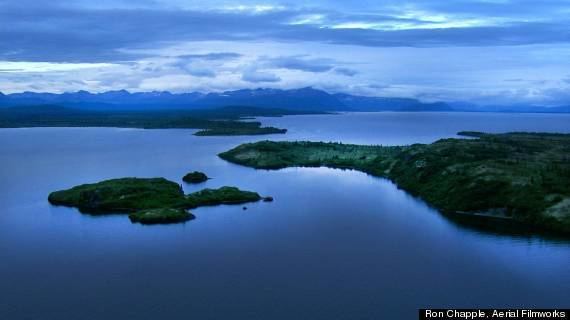Basin countries United States Area 2,622 km² Surface elevation 14 m Width 35 km | Max. length 77 mi (124 km) Length 124 km Volume 115 km³ | |
 | ||
Primary inflows Fish Northern pike, Rainbow trout, Sockeye salmon, Chinook salmon, Coho salmon, Lake trout, Dolly Varden trout | ||
Iliamna lake a land worth preserving
Iliamna Lake or Lake Iliamna is a lake in southwest Alaska, at the north end of the Alaska Peninsula, between Kvichak Bay and Cook Inlet, about 100 miles (160 km) west of Seldovia, Alaska.
Contents
- Iliamna lake a land worth preserving
- Map of Iliamna Lake Alaska USA
- Name
- Williamsport Pile Bay Road portage
- Populated places
- Flora and fauna
- Monster legend
- References
Map of Iliamna Lake, Alaska, USA
It is the largest lake in Alaska, third largest lake entirely in the United States, and twenty-fourth in North America. (While all five Great Lakes are considerably larger, only Lake Michigan lies completely within US territory.) Covering about 2,600 km² (1,000 sq. miles), Iliamna Lake is 77 miles (124 km) long and up to 22 miles (35 km) wide, with a maximum depth of 988 feet (301 m). Through the Kvichak River, its waters drain into Bristol Bay.
Name
The lake is marked as 'Oz[ero] Bol[shoy] Ilyamna' (Big Ilyamna Lake) on the Russian Hydrographical Department's Chart 1455, published in 1852. On an earlier Russian map, from 1802, the lake was named 'Oz[ero] Shelekhovo' (Lake Shelekov) after Russian explorer Grigory Shelekhov. According to G.C. Martin, of the United States Geological Survey, Iliamna is said to be "the name of a mythical great blackfish supposed to inhabit this lake, which bites holes in the bidarkas of bad natives."
The name Iliamna is derived from the Inland Dena'ina Athabascan name Nila Vena, which means island's lake.
Williamsport-Pile Bay Road portage
Originally constructed by the Alaska Road Commission during the mid 1930s, the Williamsport-Pile Bay Road is a utility-class road maintained by the Alaska Department of Transportation & Public Facilities. Connecting Pile Bay on the lake's northeast side with Williamsport, a tiny settlement on the Iliamna Bay of Cook Inlet (about 100 miles (160 km) southwest of Homer), the road is 15.5 miles (24.9 km) long and one lane wide with four bridges. The Williamsport-Pile Bay Road is maintained as a gravel utility road for the purpose of hauling boats and freight, and is not intended for general purpose use. The road allows boats small enough to be hauled across the road's bridges an opportunity to portage from Cook Inlet to Bristol Bay, saving a trip on the open ocean which involves traveling around the Alaska Peninsula. For this and other reasons, the road is also believed to significantly reduce fuel costs for the Lake Iliamna and Bristol Bay regions.
Populated places
The villages of Iliamna, Newhalen, Kokhanok, Pedro Bay, Pope-Vannoy Landing and Igiugig lie on the shores of Iliamna Lake.
Flora and fauna
Iliamna Lake is noted for its sport fishing. The three primary targets of anglers in the lake are trout, salmon, and grayling. August through September is prime time for catching fat rainbow trout, some of which exceed 28 inches long. The Kvichak River Policy (the drainage of Lake Iliamna) is catch and release on trout (and all other native fish), but not on salmon. Sockeye (red) and Chinook (king) salmon are consistently found in the lake and are open to harvest under Alaska Department of Fish and Game Regulations. Lake Iliamna also has one of few populations of freshwater seals in the world. It also serves as a nursery for the largest red salmon run in the world. Red salmon spend half of their 5-year lifespan in fresh water. This is longer than any other species of salmon.
Monster legend
Local residents have a number of stories about the alleged Iliamna Lake Monster, an aquatic creature much like the rumored Loch Ness Monster. Speculation exists that reported sightings may be an undocumented population of white sturgeon. If true, this would be the most northerly population known to exist, just a few hundred miles from the Arctic Circle. Jeremy Wade, presenter of Animal Planet's River Monsters is among those who speculate these sightings of a reputed "monster" is a white sturgeon. Others believe that it is a Pacific sleeper shark. Evidence of this is corroborated by a 2012 YouTube video that shows a smaller Pacific sleeper shark in Lake Iliamna.
